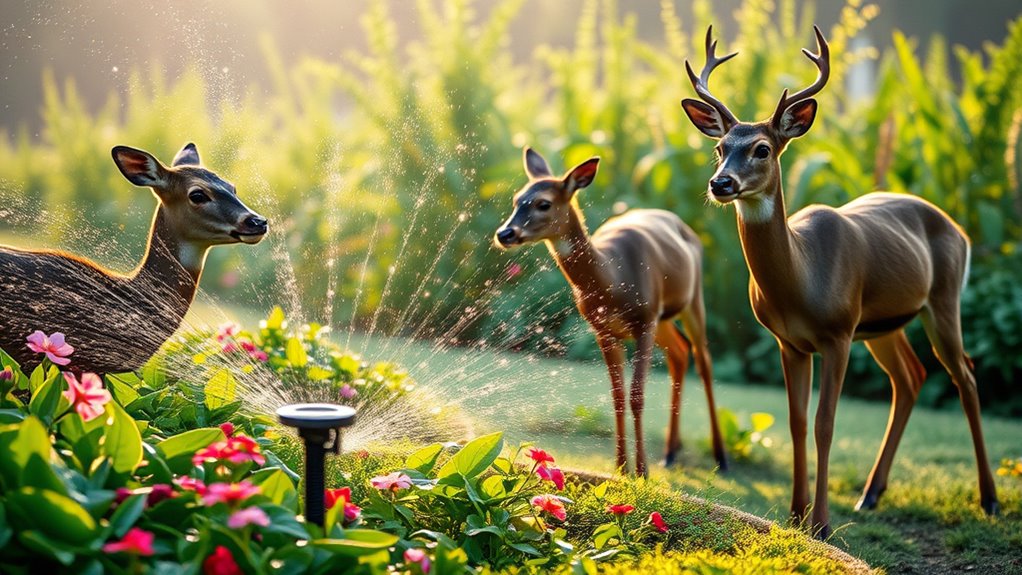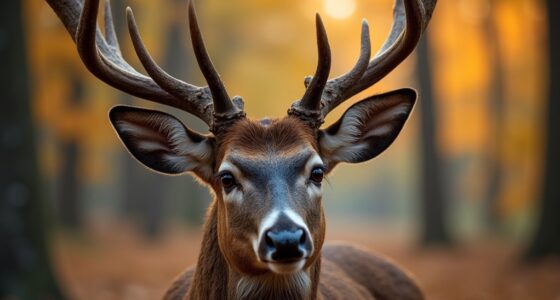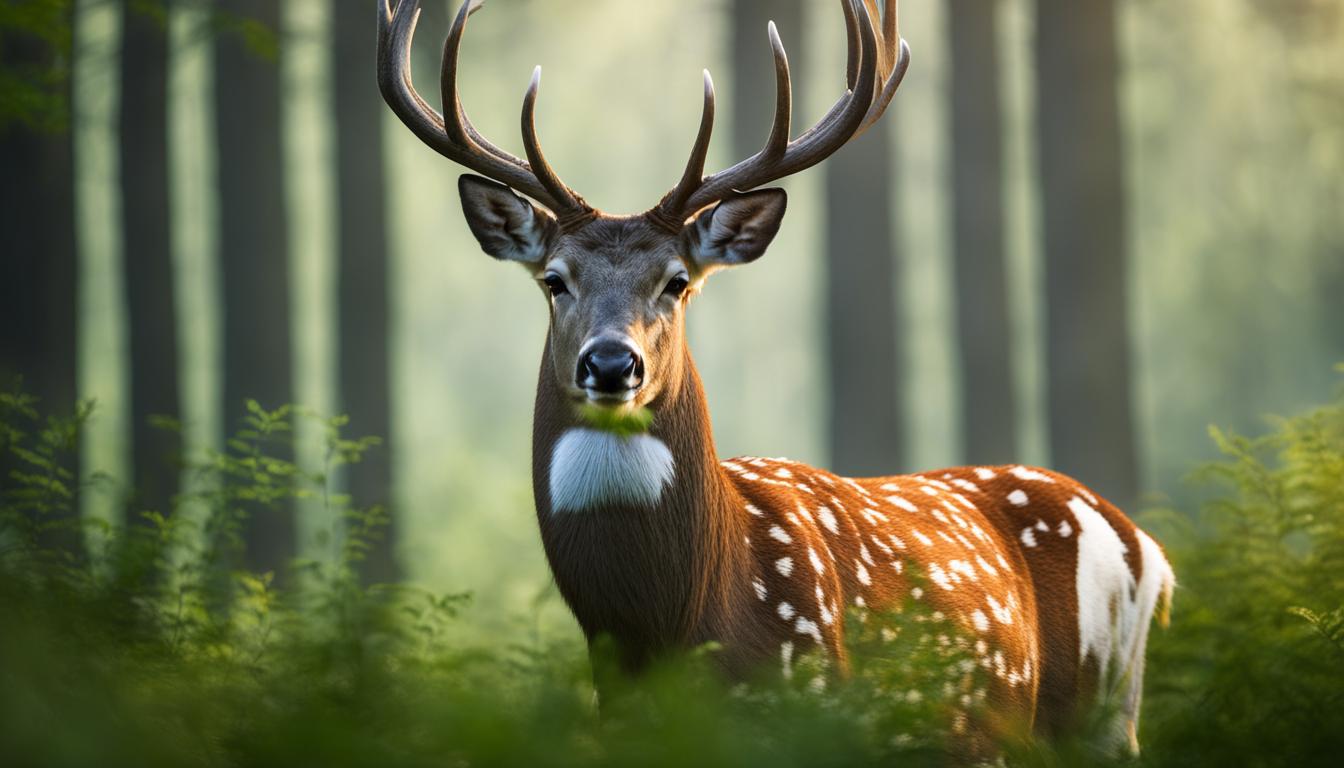Deer have become surprisingly clever at outsmarting simple motion-sensor sprinklers. They learn to recognize triggers, approach from different angles, or wait for the device to reset before returning. Sometimes, they jump over or duck under streams they’ve seen before. Basic systems often have predictable patterns that deer exploit, reducing their effectiveness over time. To better protect your garden, exploring more advanced deterrents and strategies can help, and there’s more you can do to outwit them.
Key Takeaways
- Deer learn to recognize and anticipate sprinkler activation, reducing their deterrent effect over time.
- They exploit blind spots or less sensitive areas, avoiding triggers and bypassing the system.
- Repetitive patterns make basic sprinklers predictable, allowing deer to time their approach or wait for resets.
- Habituation occurs when deer realize the sprinklers are false alarms, decreasing their fear response.
- Combining sprinklers with other deterrents and using advanced, variable systems enhances overall garden protection.

Many gardeners have relied on motion-sensor sprinklers to keep deer away from their plants, only to find that these devices often fall short of their promises. Deer behavior is surprisingly adaptable, and what once seemed like a foolproof deterrent can quickly become ineffective. These animals are clever and observant, often learning to recognize patterns or triggers that signal an impending spray. When they notice that a sprinkler activates only under certain conditions, they may test the boundaries, approaching cautiously or even waiting until the device resets to re-enter the area. This behavior makes it clear that relying solely on basic sprinkler technology may not be enough to keep deer at bay.
Deer quickly learn and outsmart basic motion-sensor sprinklers, making them less effective over time.
Sprinkler technology has advanced considerably, but many models still operate on simple motion detection, which deer learn to evade. For example, if a sprinkler activates only when a deer steps into a specific zone, the animal might simply approach from a different angle or time their visits to avoid triggering the sensor. Some deer may even jump over or duck under the streams if they learn the pattern. Moreover, if your sprinkler system is not sensitive enough or if it has blind spots, deer can quickly exploit these weaknesses. The technology can sometimes be too predictable, providing the deer with an opportunity to outsmart it through repeated trial and error. Additionally, the materials used in some sprinkler systems may not be durable enough to withstand persistent attempts by clever deer.
To combat this, you need to understand deer behavior more deeply. They tend to avoid areas that pose a real threat, but they can also become habituated to false alarms if they realize the sprinkler isn’t dangerous. That’s why it’s essential to combine motion-sensor sprinklers with other deterrents or to upgrade to more advanced systems that incorporate multiple sensors, sound, or even variable spray patterns. Some newer models use infrared sensors or ultrasonic devices that produce sounds uncomfortable for deer but inaudible to humans. Others incorporate random activation patterns, making it harder for deer to learn and adapt.
Ultimately, understanding how deer behave and recognizing the limitations of sprinkler technology can help you develop a more effective strategy. Instead of relying solely on one method, combine physical barriers, repellents, and smarter sprinkler systems to increase your chances of protecting your garden. Deer are resourceful, but with the right approach, you can make your garden less inviting and discourage their visits, ensuring your plants stay safe from these clever visitors. Incorporating diverse deterrent tactics can significantly improve your success rate.
Frequently Asked Questions
Can Deer Develop Immunity to Motion Sensors Over Time?
You might wonder if deer can develop immunity to motion sensors over time. Deer learning and sensor adaptation are real concerns, as clever animals often figure out how to bypass deterrents. While some deer may start ignoring sensors, varying your approach can help. Regularly changing sensor placement or combining different deterrents prevents deer from learning patterns, keeping your garden protected longer and reducing their ability to adapt to your defenses.
Are There Alternative Deterrents More Effective Than Sprinkler Systems?
You wonder if there are better options than sprinkler systems to keep deer away. Scent deterrents like predator urine or commercial repellents can be effective, especially when combined with physical barriers such as fencing or netting. These methods work by making your garden less appealing or harder to access. Using a mix of scent deterrents and physical barriers increases your chances of successfully protecting your plants from deer intrusion.
How Do Weather Changes Affect the Effectiveness of Motion Sensors?
Weather changes can turn your sensor’s effectiveness into a wild rollercoaster ride. Rain or fog can fool the sensor into thinking there’s movement, while wind might set it off unnecessarily. To keep your defenses sharp, you need proper sensor calibration and weather adaptation. By adjusting settings for different conditions, you guarantee your sprinkler stays vigilant, guarding your garden like a loyal sentry, regardless of the weather’s unpredictable mood swings.
What Are Natural Deer Repellents That Don’t Involve Technology?
You can try natural deer repellents like companion planting, which involves growing plants deer dislike, such as lavender or mint, around your garden. Biological control methods, like introducing predator scents or encouraging natural predators, also help. These techniques create an environment that’s less attractive to deer without relying on technology. Consistently applying these strategies can make your garden less appealing, reducing deer visits effectively and safely.
How Can I Identify the Specific Deer Causing the Problem?
To identify the specific deer causing the problem, start with deer tracking by observing your yard during dawn or dusk. Look for fresh tracks and footprints in soft soil or mud, noting their size and shape. Identifying tracks helps you recognize which deer are visiting, whether it’s a lone buck or a herd. Use these clues to better understand their activity patterns and tailor natural repellents accordingly.
Conclusion
So, next time you set up those motion-sensor sprinklers, remember—you’re not just battling deer, you’re facing off against stealthy masterminds that could outwit even the most high-tech defenses. They slip past like ninja shadows, leaving your garden’s beauty trembling in fear. Until you outsmart these clever creatures, your plants might as well be surrendering to an army of tiny, cunning invaders. Stay vigilant, or watch your garden fall under their sneaky reign!










